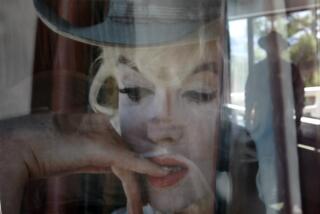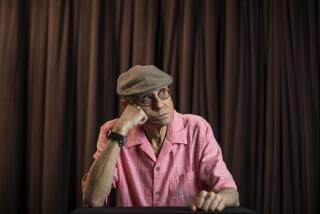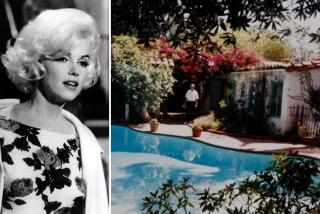The Strange ‘Truth’ of ‘Marilyn, Me’
- Share via
It is 1946. Wearing a dress with a plunging neckline, Norma Jeane Baker enters a studio reception room and trips, falling forward on all fours. Like a slobbery voyeur, the camera moves in for a leering close-up, transferring our eyes to her panoramic breasts while she speaks at length with the young man who has rushed to her aid.
Did it really happen? Did any of “Marilyn and Me” (airing at 9 p.m. Sunday on Channels 7, 3, 10 and 42) really happen as it is told? The spotty record of TV docudrama itself is a viewer advisory, urging skepticism on our part, especially regarding movies asking us to swallow what they tell us about celebrities.
And this flat, uninvolving and above all somewhat dubious ABC movie--depicting one man’s account of his alleged enduring relationship with Norma Jeane Baker/Marilyn Monroe--asks us to believe a lot.
It asks us to believe that a relatively obscure writer named Robert F. Slatzer was Monroe’s secret husband for five days, that he got her pregnant and was with her in Tijuana when she got an abortion on a kitchen table.
It asks us to believe that Slatzer intimately knew Walter Winchell, that he had a run-in with Joe DiMaggio over Monroe, that he was present when she posed for her famous nude calendar portrait, that his presence on the set of “Niagara” in 1952 settled her down so that she could finish the movie that would zoom her to stardom.
It asks us to believe that Slatzer, a man whose presence beside Monroe amazingly few people seem to have noticed, was her close friend and confidant throughout her Hollywood years.
Will Fowler says he doesn’t believe it. Slatzer’s story is “filled with lies,” charges Fowler, who claims he ghost wrote the first two drafts of Slatzer’s 1974 book, “The Life & Curious Death of Marilyn Monroe,” on which much of the ABC movie is based. He says he withdrew as writer after becoming convinced that Slatzer’s account was “baloney.”
Slatzer, however, says it’s Fowler who’s full of baloney. Moreover, he and Andrew Ettinger, former editorial director at Pinnacle Books, publisher of Slatzer’s account, maintain that Fowler is exaggerating his role, that he was involved only in editing and rewriting and that he was dropped from the project for failure to produce.
More about Marilyn and them shortly.
Although Susan Griffiths (a veteran of the Monroe look-alike circuit) captures a certain dreamy elusiveness that syncs with Monroe’s public personality, “Marilyn and Me” is devoid of insights, the “me” taking precedence over the Marilyn in producer Robert Boris’ teleplay.
Slatzer (Jesse Dabson) is depicted as earnest and loyal. In Hollywood at 19 to scrounge interviews for an Ohio paper, he meets 20-year-old, then-brunette Norman Jeane in that studio reception room and is immediately infatuated. She asks him for a date, and that night she strips on a public beach, where, we’re given the impression, she seduces him.
Thus, according to Slatzer’s account, unfolds the opening chapter in a relationship that he maintains was essentially close and lasting through the years, even though he and Monroe were intermittently apart.
There are some sequences here that seem phony on the surface. One of them has Monroe and Slatzer breaking into the old Rudolf Valentino mansion, where a guard discovers them and, instead of kicking them out, puts on a tango record so they can dance. Another has Marilyn crashing the funeral and throwing herself on the coffin of her agent/mentor (and lover, according to this account), Johnny Hyde (Joel Grey).
At the heart of the debate over “Marilyn and Me,” however, is its portrayal of Slatzer’s undocumented, alleged secret-quickie marriage to Monroe in Mexico in 1952. In the movie, Monroe proposes to Slatzer after Joe DiMaggio, the man she’ll later marry, proposes to her. Then Monroe’s boss, 20th Century Fox studio chief Darryl F. Zanuck, somehow finds out about her marriage to Slatzer, and they obey his order to dissolve it.
No marriage certificate exists today. Slatzer says that Monroe’s certificate has disappeared and that another certificate was destroyed on their instructions by an attorney in Mexico when they were there getting their marriage dissolved. The only person still alive who could verify the marriage, he said, is actress Terry Moore (who has a small part in the ABC movie). Moore did not return calls made to her this week.
Actress Susan Strasberg and others who were close to Monroe say the fact that they had no knowledge of the alleged Slatzer-Monroe relationship doesn’t necessarily mean it didn’t exist. “She kind of compartmentalized her friends,” Strasberg said.
Fowler, whose long writing career in Los Angeles has included stints as a newspaperman, publicist and novelist, is a much harsher critic. He contends that when Slatzer approached him about writing a book about Monroe in 1972, the subject was to be the mystery surrounding her 1962 death, which was ruled a suicide. Fowler recalls: “I said in the beginning, ‘If you were married to Marilyn, you’d really have a book here.’ Then a few days later he came to me and said, ‘I didn’t want to say anything, but I was married to her, but it was only for a weekend.’ ”
According to Fowler, he ended his association with the book after becoming suspicious when Slatzer’s story “kept changing.”
Nonetheless, Fowler said, he had always regarded Slatzer as being harmless until hearing that ABC was going to make a movie drawn largely from “The Life & Curious Death of Marilyn Monroe” that would depict not only the alleged marriage but also mention an abortion that Slatzer claims Monroe had. “That made me so sick and so mad,” he said.
Fowler says he is convinced that Slatzer never even met Monroe until getting himself photographed with her on the set of “Niagara.”
“I deny every allegation he has ever made,” Slatzer said of Fowler. “He is a mean and jealous man.” Slatzer offered as “evidence” a copy of a letter to him dated Aug. 15, 1982, purportedly signed by Fowler and appearing to accept Slatzer’s account of the marriage.
Fowler said he never wrote such a letter.
And Slatzer says he can’t account for Fowler’s “evidence” that a scene in the movie showing Slatzer and DiMaggio confronting each other over Monroe is erroneous. The “evidence” includes a note purportedly written to Fowler from DiMaggio. “I never met Robert Slatzer,” the note says above a signature purportedly that of DiMaggio. Fowler also produced an audio tape of himself asking someone about DiMaggio and a voice replying, “I never talked to him.” Fowler claims the tape was of a telephone conversation he had with Slatzer in 1973.
DiMaggio could not be reached for comment.
Slatzer is listed as a “consultant” on “Marilyn and Me,” a production of Samuels Film Company. Christine Hikawa, vice president for ABC broadcast standards and practices, said that her office interviewed Slatzer and found him “credible.” She said network researchers also consulted “independent sources” about Slatzer and found material in three books that “supported his claims.”
However, none of the books she cited provides documentation of the alleged marriage, and none even mentions the alleged abortion.
Hikawa said that ABC stands behind the movie. Whatever that is worth.
ABC’s record as a historian is uneven. “In certain biographies, ratings rate higher than research,” said prominent producer Stan Margulies, whose miniseries “Separate but Equal” for ABC recently won an Emmy, but whose plans for an NBC miniseries on Rock Hudson were shot down when ABC, moving faster and relying on different sources, aired its own Hudson biography that was highly questionable.
“On Thurgood Marshall (the central character in ‘Separate but Equal’), they really dug into the material and did their own research and asked hundreds and hundreds of questions,” Margulies said. “In the case of Rock Hudson, they didn’t do that, and there were many facts that were, let us say, suspect.”
There’s a scene in Sunday’s Marilyn movie in which the Slatzer character almost seems to be pleading for trust. “Incredible, isn’t it?” he says about the story he is telling in flashback. “But I swear it’s true.”
Others have sworn that their stories about Monroe were true too. “I read about a guy who said Marilyn had six toes and he sat with her in the doctor’s office while she had the sixth toe removed,” Strasberg said. “But, you know, she was the mystery queen. There were so many cloudy areas in her life, she made all of this possible.”
More to Read
The complete guide to home viewing
Get Screen Gab for everything about the TV shows and streaming movies everyone’s talking about.
You may occasionally receive promotional content from the Los Angeles Times.






